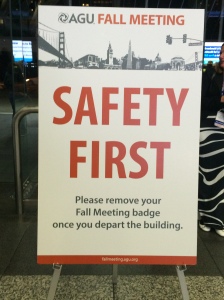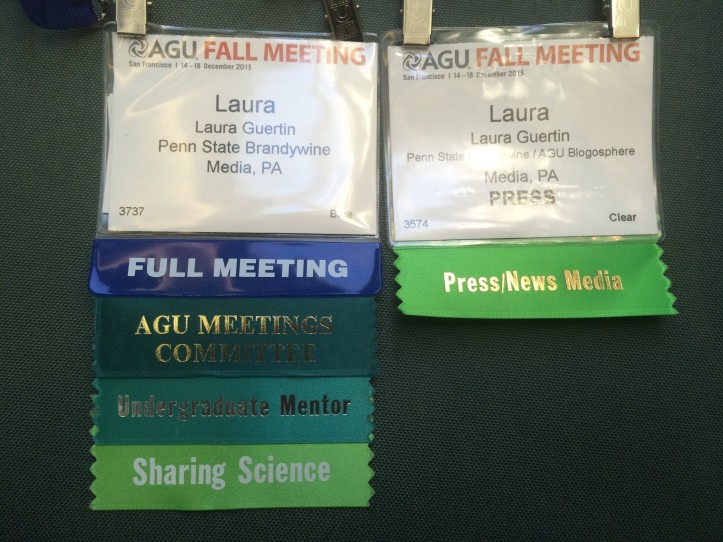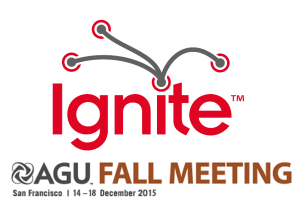This is one of a series of blog posts on the Journeys of Dr. G blog for the 2015 AGU Fall Meeting. Feel free to read my posts for pre-meeting, Sunday, Monday, Tuesday, Thursday, and Friday.
Wednesday was just as busy as all of my previous days at AGU – much work, but much fun connecting with colleagues while hearing the “latest and greatest” in the Earth sciences.
 One quick note before I dive into the details of my day… as I know students like to hear these small sidebar stories… as with any large conference in any major city, I’ve always found the city to be aware of and concerned about the safety of visitors that travel from out of town, out of state, and out of the country. This year especially, I have noticed the San Francisco Police as a very visible presence at the major intersections near the convention center and inside when the Tesla was on display, when Elon Musk spoke, when Al Gore spoke, etc. (more on Al Gore soon!) One action that AGU takes is to place this sign at the main exits to the convention center – nothing will identify a person more as a visitor walking down the street than wearing a conference name badge! Although, this tweet brings up a good point…
One quick note before I dive into the details of my day… as I know students like to hear these small sidebar stories… as with any large conference in any major city, I’ve always found the city to be aware of and concerned about the safety of visitors that travel from out of town, out of state, and out of the country. This year especially, I have noticed the San Francisco Police as a very visible presence at the major intersections near the convention center and inside when the Tesla was on display, when Elon Musk spoke, when Al Gore spoke, etc. (more on Al Gore soon!) One action that AGU takes is to place this sign at the main exits to the convention center – nothing will identify a person more as a visitor walking down the street than wearing a conference name badge! Although, this tweet brings up a good point…
With over 3,000 posters on display each day of the conference (that’s five days, ~3,000 posters each day, for a total of ~15,000 posters presented at AGU!), there are many, many poster tubes on the streets of San Francisco!

By the way, for the name badge, I have two for this meeting! One is the regular conference badge for presenters. The name badges always list your name and your institution or organization affiliation. Next is whether you are registered for the full conference, or just for one day of the meeting (there’s a significant price difference between the two rates). Next up are the “ribbons”, which reflect leadership roles in the organization or roles one is playing at the meeting. This year, I have three ribbons on this one badge – one for being a member of the AGU Meetings Committee (a committee I joined earlier this year), a participant in the meeting Undergraduate Mentoring Program, and a part of the AGU Sharing Science network (as I blog for AGU). And then, I have a second name badge! As an AGU Blogger, I’m considered part of the press covering the meeting. This requires me to have a second name badge that allows me access to press conferences and the press room. Some people look at me strangely for wearing two name badges, but these are the roles I’m playing at AGU.

But on to describing Wednesday’s adventures! The morning was open time for me to catch some talks, posters, and connect with people in the Exhibit Hall. At 12:30PM, it was time for the Town Hall panel session I was chairing on “National Academy of Sciences Convocation Report: Integrating Discovery-Based Research Experiences into the Undergraduate STEM Curriculum“. This Town Hall was an extension of the poster I presented on Monday, and it was a chance for myself, the National Academy of Sciences, and the other professionals that I collaborate with to have the opportunity to further share our work during a significant time slot at the meeting. (Note that a “Town Hall” is defined as an opportunity for government agencies, academic programs, special projects, and other focused interest groups to gather input from the broader AGU Community). Alas, we didn’t have as many people fill the 500-seat room as we had hoped, because at the same time, former Vice President Al Gore was speaking! Ugh! He stole our audience! I heard the line to get in to see him was not nearly as long as the line to see Elon Musk, but still, he had a full crowd eager to hear him speak about “The Earth from a Million Miles: Advancing Earth Observations from L1“. This is one of the realities of conferences – multiple events are scheduled at the same time, and there’s a real chance that someone more popular than you will be the speaker that meeting attendees gravitate towards. But, my panel and I still had a great session with the people that were there with some meaningful discussion, and that’s what matters the most in the end.
I spent the afternoon in a workshop titled “Revealing the New Arctic: A Climate Change Communication Workshop.” The workshop was run by Andy Revkin, Dot Earth blogger with The New York Times and performer of the song Liberated Carbon (which he sung at the Open Mic night last night). The workshop explored the process and importance of finding creative outlets for Arctic science, stories, and images. This workshop was packed with information and went by very fast! I heard about blogging for the Arctic, sonificaiton of the melting ice sheets in Greenland, and 3D scanning and printing of not only the surface but of what is under ice sheets. It is really exciting to see how advances in technology, partnered with creativity, can perhaps help get the message across of what is happening in the Arctic. The take-home messages for me were that: (a) scientists need to add scientific communication to their scientific skill set; (b) know your audience – their sophistication, bandwidth, and do not “dumb down” the science but use appropriate vocabulary; (c) summaries and 2-minute videos must serve as entry points for people to explore and learn more; (d) people want stories, and scientists need to put their data in a story format; and finally, (e) stop making science communication an afterthought – make it a forethought.
 My final event for the day was attending the Ignite@AGU event. Here is a description:
My final event for the day was attending the Ignite@AGU event. Here is a description:
Ignite gives speakers a strict presentation format: five minutes and 20 slides that auto-advance every 15 seconds. The rapid-fire pace of this format makes for fun, frenetic delivery and keeps the audience engaged. Ignite presenters span domains and organizations, and range from graduate students to senior-level researchers, science journalists, educators and others. Some talks are about serious science, others are more lighthearted, but all focus on a compelling idea or story. Ignite talks are not your average scientific conference talks — speakers are encouraged to push boundaries and be creative, funny and thought-provoking.
I have a full report on Ignite@AGU on my AGU Blog – I encourage you to read more about this fun and focused format for sharing science – but keep in mind, this format can be used for any discipline! So how about it students – could you speak for five minutes with 20 slides that auto-advance on you???
Now entering the home stretch of the meeting!

[…] G blog for the 2015 AGU Fall Meeting. Feel free to read my posts for pre-meeting, Sunday, Monday, Wednesday, Thursday, and […]
LikeLike
[…] G blog for the 2015 AGU Fall Meeting. Feel free to read my posts for pre-meeting, Sunday, Tuesday, Wednesday, Thursday, and […]
LikeLike
[…] Feel free to read my first post, pre-meeting, and the remainder of the week (Monday, Tuesday, Wednesday, Thursday, and […]
LikeLike
[…] Dr. G blog for the 2015 AGU Fall Meeting. Feel free to read my posts for Sunday, Monday, Tuesday, Wednesday, Thursday, and […]
LikeLike
[…] for the 2015 AGU Fall Meeting. Feel free to read my posts for pre-meeting, Sunday, Monday, Tuesday, Wednesday, and […]
LikeLike
[…] for the 2015 AGU Fall Meeting. Feel free to read my posts for pre-meeting, Sunday, Monday, Tuesday, Wednesday, and […]
LikeLike